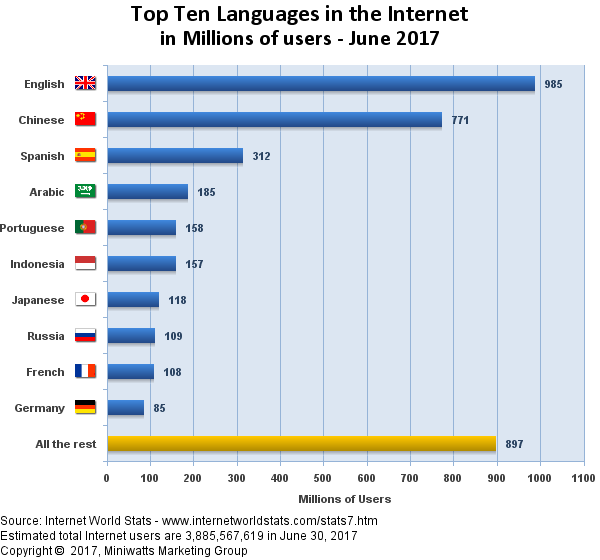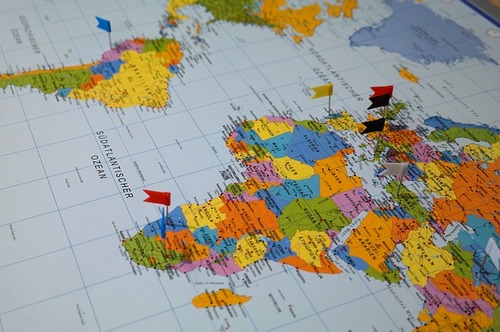The Internet is one mighty communication tool. Millions of people around the world are able to communicate via the Internet through different platforms, from email and social media networks to file sharing, and internet languages vary.
Many studies have been conducted on how technology and access to information affect linguistic diversity, internet languages and globalization. Some major languages rule the Internet while the speakers of minority and endangered languages are trying to bridge the digital language divide with whatever benefits the Internet offers them.
Aside from the wealth of information that resides in the vast Internet universe, it is also a hub for simultaneous and constant conversations in a multitude of internet languages, both major and obscure, ongoing wherever Internet access is available.
Related Post: Did You Know Your Language Changes How You See Color?
The Internet
The World Wide Web went live on August 6, 1991, so this year (2017) it is already 26 years old. The use of the Internet started much earlier among communities of researchers and computer engineers.
Access to the Internet at its initial stage was quite rare but its growth was rapid. About 0.04 percent of the population around the world had access in 1995, with most of them located in the United States.
For the first 10 years of the 21st century, consumers in developed countries were already using broadband technology. In 2014, 41 percent of the world’s population already had access.
Internet Languages
With most of the Internet users living in the U.S., English is the first digital language used for communication and document exchanges. It was estimated that about 80 percent of web content available in the mid-1990s were in English.
English is still a dominant language on the web, but more languages are appearing in the list. In the survey results released by Internet World Stats for June 2017, the list of top internet languages used is as follows:
According to the results, the use of English on the web grew smaller to about 30 percent. Catching up to English are other languages such as Chinese, Spanish, German and French. Among the internet languages used in cyberspace, Chinese is the faster growing language. Within 10 years from 2000 to 2010, it grew by 1,277.4 percent.
English still dominates but Chinese is not far behind in terms of Internet penetration and language use. Just look at the online growth of Chinese language from 2000 to 2017.
Languages in Social Media
The top languages spoken in the world are dependent on the size of the population of each country, therefore English and Chinese dominate. But in terms of social media, the use of different languages is more varied, making the digital language divide somewhat smaller.
Most social platforms are multi-lingual, although there are some local platforms that are available only in one language, such as China’s Sina Weibo and VK, which is in Russian. China is a special case because international social network platforms are banned in the country.
The language you speak matters when you are online because it affects your ability to access information and to communicate. According to various studies, your mother tongue determines how much information you can access.
This means that it also depends on the languages available for the information you seek. For example, if you are searching for a “pub” or “bar,” you’ll have more results in English than in any other language.
Moreover, your first language guides whom you speak with when you are online. Even if the communication gap is getting narrower, the language you speak becomes the basis of your identity and automatically draws the lines of inclusion and exclusion. Communities grow because of the commonality in interests and languages.
On Twitter for example, English is the most common language for tweets. However, nearly 50 percent of tweets are in languages other than English, with Indonesian, Portuguese, Spanish and Japanese topping the list among active users.
Analysts say that users of Twitter still confine their activities, such as tweets and retweets, as well as follows to those people who speak the same language. So, even if Twitter espouses global conversations, the interaction of users are still limited and divided by language.
Twitter users also display different behaviors. Since there is a 140-character in a tweet, English speakers will write less than Chinese users. The reasons for using Twitter are divided by language groups. For example, Germans typically use it for sharing information, with hashtags and URLs, while others, such as Koreans, use it for conversations.
A research conducted by the Journal of Cross-cultural Psychology on bilingual Facebook users found the English speakers are more individual when it comes to posts and shares. The analysis done on Renren, which is the Chinese equivalent of Facebook, showed that users often shared posts for a wider group’s benefit.
Disparity in the Availability of Information
It is not just in social network platforms that the disparity in internet languages exists. The amount of information available on the web also vastly differs. Wikipedia officially has 288 language editions, but the majority of information is in English, while other internet languages have limited information. English is followed by French and German. Researchers found that there is very limited content, if at all, in Asian and African languages.
About 7,000 languages are used today, yet Google, which is the most popular search engine that has the capability to recognize 30 European languages, can only recognize one language from Africa.
The search engine is not able to recognize Pacific and indigenous American languages. So far, Google’s language recognition capability is limited to 123 languages for its worldwide users. However, some countries have their own local search engines that compete with Google.
Yahoo is still used widely in Taiwan and Japan, and the latter also has Goo. The Czech Republic has Seznam.cz, while Russia has Yandex. Soso.com and Baidu are big in China and South Koreans use Daum.net and Naver.com. Baidu and Naver are crossing over to Japan as well.
You might assume that for the top internet languages, the same amount of content or information for universal themes would be available in Wikipedia, for example. Surprisingly, this is not the case in its different editions. Even if there were a massive amount of information in English, nearly half would be missing in the second most popular language, German.
Taking Wikipedia as the representative sample for other information available on the World Wide Web, it is easy to surmise that the situation would be the same for other content from various sources.
Related Post: How Many Languages Are There in The World?
Online Representation
It is easy to conclude that only a few dominant internet languages enjoy massive representation, which means there is still inequality in information availability in many other languages. Although Internet availability and coverage increases, there are still many cultures and languages that are not represented in internet languages.
These people then have to use their second language if they have one or else learn to use one of the represented internet languages. Otherwise, their access to online information would be very limited and their communication would still be among members of their language community.
Although, as mentioned earlier, this is an ongoing trend, as fluency in another language as well as their innate characteristics may inhibit them from interacting with people who speak a language different from their own.
How to Bridge the Internet Languages Divide
Translation is still one of the most viable solutions to bridge the division of digital languages. Bing has teamed up with Twitter and Facebook to offer translation services to their users, while Microsoft has introduced Skype Translator.
The numbers for different internet languages users are not always conclusive. In one study, it was found out the number of first language users in different languages prefer to use English when sending Tweets or editing Wikipedia content. This only means that even multilingual users switch to another language in order to interact with others.
Translation tool may be effective for use in social media and short communication and conversation purposes on the Internet. However, for official documentation and exchange of information that needs formality, professional translation is necessary. You have to hire a professional translator to transfer the content from the source language to the target language with a high degree of clarity and accuracy.
At this stage, researchers and analysts predict that the majority of languages spoken today will lose traction in online communication. The digital language divide is difficult to surmount. Right now there are only a few major languages that are in use, and it is probable that many minor and obscure languages would never be represented online. On the other hand, the increasing access to the Internet may change the scenario and narrow the gap between digital languages.
The Internet is a powerful communication tool. It can be used to educate, document and preserve languages. Many organizations are spearheading projects to preserve endangered languages and are using online platforms to reach out to first language speakers and translate information valuable to marginalized cultures.
While multilingualism and online linguistic diversity it encouraged, it is still up to the language speakers to choose which language they prefer to use to maximize their Internet experience.














Sorry, the comment form is closed at this time.